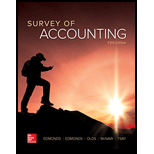
Exercise 1-10 Interpreting the
The financial condition of White Co. Inc. is expressed in the following accounting equation:
Assets = Liabilities + Common stock +
$1,800 Cash + $12,000 Land = $6,000 + $5,000 + $2,800
Required
a. Are dividends paid to creditors or investors? Explain why.
b. How much cash is in the Retained Earnings account?
c. Determine the maximum dividend White Co. Inc. can pay.
d. If the obligation to creditors is due, can White Co. Inc. repay the loan? Why or why not?
e. Suppose the land sinks into the sea as a result of an earthquake and a resulting tsunami. The business is then liquidated. How much cash will creditors receive? How much cash will investors receive? (Assume there are no legal fees or other costs of liquidation.)
Want to see the full answer?
Check out a sample textbook solution
Chapter 1 Solutions
Survey Of Accounting
- Can you solve this general accounting problem with appropriate steps and explanations?arrow_forwardI am trying to find the accurate solution to this general accounting problem with the correct explanation.arrow_forward← Week 1: Homework Question 3 of 4 8.75/10 The project is completed in 2025, and a successful patent is obtained. The R&D costs to complete the project are $113,000. The administrative and legal expenses incurred in obtaining patent number 472-1001-84 in 2025 total $16,000. The patent has an expected useful life of 5 years. Record the costs for 2025 in journal entry form. Also, record patent amortization (full year) in 2025. (Credit account titles are automatically indented when amount is entered. Do not indent manually. If no entry is required, select "No Entry" for the account titles and enter O for the amounts. List all debit entries before credit entries.) Account Titles and Explanation Research and Development Expense Cash (To record research and development costs) Patents Cash (To record legal and administrative costs) Amortization Expense Patents (To record one year's amortization expense) Debit 113000 16000 3200 Credit 113000 16000 3200arrow_forward
 College Accounting, Chapters 1-27AccountingISBN:9781337794756Author:HEINTZ, James A.Publisher:Cengage Learning,
College Accounting, Chapters 1-27AccountingISBN:9781337794756Author:HEINTZ, James A.Publisher:Cengage Learning, Financial And Managerial AccountingAccountingISBN:9781337902663Author:WARREN, Carl S.Publisher:Cengage Learning,
Financial And Managerial AccountingAccountingISBN:9781337902663Author:WARREN, Carl S.Publisher:Cengage Learning,


